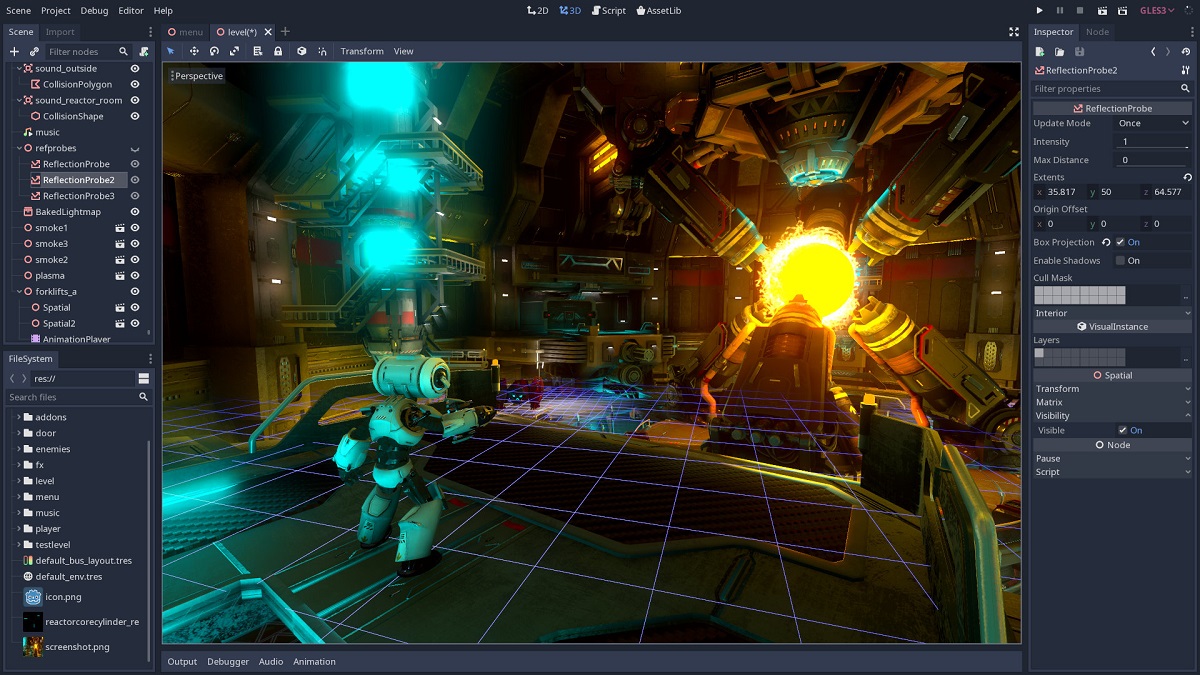
After 10 months of development, Godot 3.2 Free Game Engine Launch Released, which is suitable for creating 2D and 3D games. The motor supports easy-to-learn language to specify the logic of the game, a graphical environment to design games, a one-click game deployment system, extensive animation and simulation of physical processes, a built-in debugger, and a system for identifying performance bottlenecks.
And motor Supports all popular stationary and mobile platforms (Linux, Windows, macOS, Wii, Nintendo 3DS, PlayStation 3, PS Vita, Android, iOS, BBX), as well as the development of games for the Web. Ready-to-run binary builds are designed for Linux, Windows, and macOS.
In a separate branch, a new backend is being developed rendering based on the Vulkan graphical API, who will be offered in the next version of godot 4.0, instead of the current backends via OpenGL ES 3.0 and OpenGL 3.3 (Support for OpenGL ES and OpenGL will be maintained through the old OpenGL ES 2.0 / OpenGL 2.1 backend operation on the new rendering architecture based on Vulkan).
The code for the game engine, game development environment, and related development tools (physical engine, sound server, 2D / 3D rendering backends, etc.) are distributed under the MIT license.
Main new features of Godot 3.2
In this new version support was added for Oculus Quest virtual reality headsets, implemented on the basis of a plugin for the Android platform. For the development of augmented reality systems for iOS, support for the ARKit framework has been added. Support for the ARCore framework is being developed for Android, but it is not ready yet and will be included in one of the 3.3.x intermediate releases;
Redesigned interface for the visual shader editor. Were added new nodes to create more advanced shaders. For shaders implemented by classic scripts, support has been added for constants, arrays, and "variable" modifiers. Many specific OpenGL ES 3.0 backend shaders are ported to OpenGL ES 2.
Support for the physically correct representation of materials (PBR) syncs with the capabilities of the new PBR rendering engines, such as Blender Eevee and Substance Designer, to provide a similar scene visualization in Godot and the 3D modeling packages used;
Various rendering settings have been optimized to improve performance and improve image quality. Many features from GLES3 were carried over to the GLES3 backend, including support for the MSAA (Multi-Sample Anti-Aliasing) smoothing method and various post-processing effects (glow, DOF blur, and BCS).
Added full support for importing 3D scenes and models in glTF 2.0 format (GL Streaming Format) and added initial support for the FBX format, which allows you to import scenes with animations from Blender, but it is not yet supported by Maya and 3ds Max.
Added support for skeleton skins when importing scenes via glTF 2.0 and FBX, which allows to use a skeleton in several meshes.
Work to improve and stabilize glTF 2.0 support was carried out in conjunction with the Blender package developer community, in which improved glTF 2.0 support will be proposed in version 2.83.
The engine's networking capabilities are extended with support for the WebRTC and WebSocket protocols, as well as the ability to use UDP in multicast mode.
Added API to use crypto hashes and work with certificates. Added a graphical interface to profile network activity. Work has started on creating a Godot port for WebAssembly / HTML5, which allows you to launch the editor in a browser via the web.
Reworked plug-in for Android platform system and export. Now for Android package formation, two separate export systems are offered: one with a pre-assembled engine and the second that allows you to create your own assemblies based on custom engine options.
If you want to know more about it, you can consult the release note.